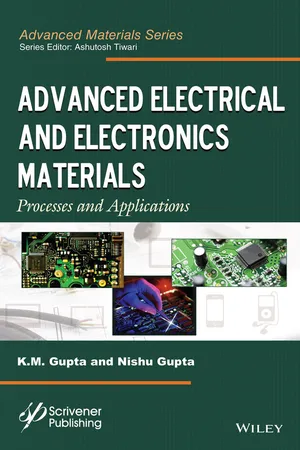
Advanced Electrical and Electronics Materials
Processes and Applications
- English
- ePUB (mobile friendly)
- Available on iOS & Android
Advanced Electrical and Electronics Materials
Processes and Applications
About this book
This comprehensive and unique book is intended to cover the vast and fast-growing field of electrical and electronic materials and their engineering in accordance with modern developments. Basic and pre-requisite information has been included for easy transition to more complex topics. Latest developments in various fields of materials and their sciences/engineering, processing and applications have been included. Latest topics like PLZT, vacuum as insulator, fiber-optics, high temperature superconductors, smart materials, ferromagnetic semiconductors etc. are covered. Illustrations and examples encompass different engineering disciplines such as robotics, electrical, mechanical, electronics, instrumentation and control, computer, and their inter-disciplinary branches. A variety of materials ranging from iridium to garnets, microelectronics, micro alloys to memory devices, left-handed materials, advanced and futuristic materials are described in detail.
Frequently asked questions
- Essential is ideal for learners and professionals who enjoy exploring a wide range of subjects. Access the Essential Library with 800,000+ trusted titles and best-sellers across business, personal growth, and the humanities. Includes unlimited reading time and Standard Read Aloud voice.
- Complete: Perfect for advanced learners and researchers needing full, unrestricted access. Unlock 1.4M+ books across hundreds of subjects, including academic and specialized titles. The Complete Plan also includes advanced features like Premium Read Aloud and Research Assistant.
Please note we cannot support devices running on iOS 13 and Android 7 or earlier. Learn more about using the app.
Information
Chapter 1
General Introduction to Electrical and Electronic Materials
1.1 Importance of Materials
- Civil engineering materials,
- Electrical engineering materials,
- Mechanical engineering materials,
- Electronics engineering materials,
- Nuclear engineering materials, and
- Computer engineering materials etc.
1.2 Importance of Electrical and Electronic Materials
Table of contents
- Cover
- Title page
- Copyright page
- Dedication
- Preface
- Acknowledgement
- About the Authors
- Abbreviations
- Chapter 1: General Introduction to Electrical and Electronic Materials
- Chapter 2: Atomic Models, Bonding in Solids, Crystal Geometry, and Miller Indices
- Chapter 3: Solid Structures, Characterization of Materials, Crystal Imperfections, and Mechanical Properties of Materials
- Chapter 4: Conductive Materials: Electron Theories, Properties and Behaviour
- Chapter 5: Conductive Materials: Types and Applications
- Chapter 6: Semiconducting Materials: Properties and Behaviour
- Chapter 7: Semiconducting Materials: Types and Applications
- Chapter 8: Semiconducting Materials: Processing and Devices
- Chapter 9: Dielectric Materials: Properties and Behaviour
- Chapter 10: Dielectric Materials: Types and Applications
- Chapter 11: Magnetic Materials: Properties and Behaviour
- Chapter 12: Magnetic Materials: Types and Applications
- Chapter 13: Superconductive Materials
- Chapter 14: Passive Components (Resistors)
- Chapter 15: Passive Components (Capacitors)
- Chapter 16: Printed Circuit Board (PCB) Fabrication
- Chapter 17: Optical Properties of Materials, and Materials for Opto-Electronic Devices
- Chapter 18: Specific Materials for Electrical, Electronics, Computers, Instruments, Robotics, and Other Applications
- Chapter 19: Recent Advances and Emerging Trends in Electrical and Electronic Materials
- Appendix I: SI Prefixes of Multiples and Submultiples
- Appendix II: Greek Alphabet
- Appendix III: Conventions to be Followed While Using SI UNIT
- Appendix IV: Physical Constants
- Appendix V: Conversion Factors
- Glossary of Terminologies
- References
- Answers to Numerical Questions
- Answers to Objective Questions
- Index
- End User License Agreement